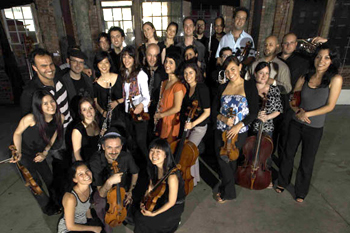Terry Rhodes, soprano, Ellen Williams, mezzo-soprano, Benton Hess, piano, Steven Reis, cello, The Raleigh Ringers. Albany Records: Troy 634 (72:14) (2004), $15.95. See http://www.albanyrecords.com/
In spite of its gimmicky title, this is a serious release of some most interesting music in generally fine performances. As can be guessed from the artist listing, there is significant variety in the offerings even though there is some inevitable sameness in the composer’s melody lines and musical treatments. The generous CD includes five song cycles with three duets from operas interspersed among them. Larsen finds some of the texts that inspire her in some of the usual places – the poetry of Elizabeth Barrett Browning, Rainer Maria Rilke (in translation), Percy Bysshe Shelley, and Emily Dickinson, for example – but the vast majority of them come from what seem to be the most unlikely sources: interviews, letters, novels, etc. Larsen obviously gets an idea and combs through many associated and related written words to find just the right ones that get her compositional juices flowing. Many of them are by strong, assertive women who spoke their minds and left their marks on their worlds even if it was only a small part of the whole wide one. Larsen uses them to make her distinctive, often indelible mark, on the listener, and through her/him, on a different and broader part of the world.
The opening cycle is the 1998 Margaret Songs , three songs using texts by Willa Cather, adapted by the composer in one case, performed by Rhodes and Hess. It is followed by a duet, with Hess playing a piano reduction accompaniment, from the 1998 opera Eric Hermannson’s Soul , libretto by Chas Rader-Scheiber, based on Cather’s short story. This is followed by the 1996 Beloved, Thou Hast Brought Me Many Flowers , billed as “A Collection of Love Songs” and sung by Williams with Hess and Reis accompanying. Then comes Rhodes’ rendition of the 1997 four-song Dickinson cycle Chanting to Paradise , incongruously yet appropriately followed by the “Color Duet” from the 2002 opera Dreaming Blue , both with Hess as collaborator. Next comes what is perhaps the most original work of the entire disk: Hell’s Belles , four songs (suggesting four stages of life: childhood, adulthood, old age, impending death) that use a conglomeration of texts assembled by the composer from interviews with Hollywood stars, a quote from Gertrude Stein, and a nursery rhyme, all accompanied by a five-octave handbell choir! You’ve never heard anything like it, and it works wonderfully well. It’s quite a change of pace from this to the duet from the 1993 opera Mrs. Dalloway (inspired by the Virginia Woolf novel of the same title, with a libretto by Bonnie Grice), with Hess again playing a piano reduction – one cannot help but picture in one’s mind the recent film of the novel as well as the even more recent novel and film The Hours , none of which had been made when the opera was composed. Concluding the CD is another astounding feat: the 1989 five-song cycle Songs from Letters: Calamity Jane to her daughter Janey , 1880-1902, brought to life by Rhodes and Hess.
Larsen merges her music with the texts seamlessly, naturally, and yet creatively. The piano part for a song involving a train ride evokes the sound of the wheels on the rails, for example, and the cello accompanies a song where a bow against a string is mentioned. For the most part, the musicians wed their talents and skills to the songs equally well. Both leave their memorable marks in the process; you would not mistake these songs for those of any other composer, and these singers have on the whole made them a part of themselves. Inevitably, some cycles seem more perfectly realized than others: Rhodes’ performance of the Calamity Jane cycle and Williams’ of Hell’s Belles strike this writer as the best, and the “Color Duet” from Dreaming Blue and the duet from Mrs. Dalloway seem more natural than the one from Eric Hermannson’s Soul . The Beloved… cycle seems the least coherent, and consequently the least sincere, as if it were difficult for Williams to get her arms around it and assimilate it into herself. That said, all the performances are successful. Balance with the collaborative musicians is excellent throughout. Diction is likewise very good everywhere, with Williams’ just a hair less crisp and clear than Rhodes’, and seeming a bit mannered in the Beloved… cycle, especially in comparison with the seeming sincerity in all the others.
The booklet contains the texts of all the works as well as composer and artist bios. The other real interest is the copious program notes, including one from Rhodes and Williams about the genesis of the recording project, one from the commissioner of the Beloved… cycle, who worked with Larsen to select the texts, and several from the composer herself about the other works. This CD is highly recommended for art song lovers and Larsen fans especially, and it is an excellent introduction to this facet of this fairly prolific composer. None of the works duplicate those found on the other CD of Larsen’s songs: love lies bleeding: Songs by Libby Larsen , with Eileen Strempel, soprano, and Sylvie Beaudette, piano (Centaur CRC 2666, 2003). Indeed, the two disks make a fine pair.











